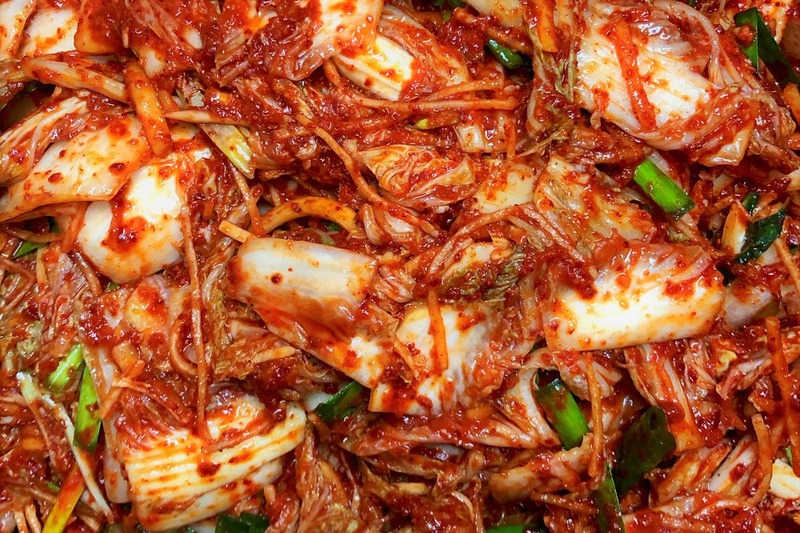We’ll see you in there.
Connect to customize your food & drink discovery.
By signing up you agree to our Terms of Service and Privacy Policy.
Mama Lee's Mak Kimchi
2 hours 30 mins Prep Time
0 mins Cook Time

Kimchi is a labour of love, but Mama Lee's recipe for mak kimchi is easy to follow so anyone can make this iconic spicy fermented cabbage at home! Check out Kimchi Korea House's IGTV on Instagram for tips and tricks on how to perfect your kimchi!
Directions
Salting Cabbage
6 Steps
Step 1
Cut your cabbage into quarters (length-wise). Trim off the core. Cut each quarter into bite size pieces, approximately 1.5"-2”-inches and place in a large bowl.
Step 2
Pour 1-2 cups of cold water over the cabbage pieces and mix to moisten evenly.
Step 3
Place 1/3 of the cabbage into another large bowl. Sprinkle 1/3 of your salt over the cabbage. Layer another 1/3 of the cabbage on top. Sprinkle another 1/3 of your salt over the cabbage. Repeat with the last 1/3 of cabbage and salt.
Step 4
Turn the cabbage over every 30 minutes to ensure the salt is evenly distributed. The total salting time for the cabbage may be 60-90 minutes. When the cabbage is salted enough, it will shrink noticeably as it releases water. The white part of the cabbage should bend a little when ready. If you’re not sure, you can rinse off the salt and taste a piece. If it doesn’t taste salty at all, it needs more time with the salt.
Step 5
After 60-90 minutes, rinse the cabbage vigorously in cold water 3 times. It is very important to rinse off all the excess salt. If your kimchi turns out too salty, it is because you did not wash the cabbage thoroughly enough!
Step 6
Allow the cabbage to fully drain in a colander for 30 minutes.
Sweet Rice Porridge
2 Steps
Step 1
Combine approximately 3 cups of water and 1/2 cup of sweet rice flour in a pot over medium heat. Bring the mixture to a boil, stirring constantly for 3-5 minutes. The mixture should be “loose”, “goopy” and translucent… more liquid than solid. If the porridge has tightened up too much, just add some more water to loosen it up.
Step 2
Set the porridge aside to cool.
Kimchi Seasoning Paste
3 Steps
Step 1
Divide your daikon radish and Asian pear in half. Roughly chop one half (to be blended into the kimchi seasoning paste) and julienne the other half (to be mixed in with the kimchi later).
Step 2
Into a food processor: add half of the amount of Asian pear, half of the amount of daikon radish, garlic, ginger, white onion and fish sauce. Process until everything is pureed.
Step 3
Pour the puree into a medium bowl. Add the salted shrimp, gochugaru (can adjust the amount based on spice preference), cooled porridge and sugar. Mix well. The colour will become more red and vibrant over the next 15-20 minutes as the gochugaru hydrates.
Assembling Kimchi
5 Steps
Step 1
In a large bowl, add your drained cabbage, julienned daikon radish, julienned Asian pear and green onions. Add approximately 3 cups of your seasoning paste to start. Mix all ingredients well.
Step 2
Taste your kimchi for seasoning! Too spicy? Add some sugar. Not spicy enough? Add more seasoning paste. Not salty enough? Add a little more fish sauce or salt.
Step 3
Pack the kimchi into an air-tight sealable plastic container or glass jar. Do not use a glass jar with a metal lid as the metal can react with kimchi. If there is a lot of air in the container, lay a piece of plastic wrap on top of the kimchi to protect it from air as it ferments.
Step 4
Your kimchi can be eaten right away! However, we like to leave it at room temperature for 1 day to kick-start fermentation then move it to the fridge. It will continue to ferment. You may see some bubbles and more liquid forming -- this is normal! Try the kimchi after 1 week to see what your preference is. As the kimchi ferments, it will become more sour and less “crunchy”. Even after 6-8 weeks, kimchi can still be eaten as is or used in cooking (e.g. kimchi pancake, kimchi stew or kimchi fried rice).
Step 5
Any leftover kimchi seasoning paste can be saved for 2-3 weeks in the fridge or 1-2 months in the freezer to make more kimchi in the future.
Recommended For You